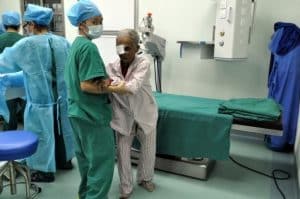Ms. Wang, a woman in her seventies, has lived three years shrouded in unending darkness. The once-vibrant landscapes surrounding her remote rural home have faded from her memory since losing her sight. Her husband’s passing left her navigating life’s complexities without his guiding presence. Daily tasks, even meals, became challenging exercises in patience and adaptation. Seated at the table, she awaited food delivered to her hand, delicately eating by touch. Yet, her true struggle lay beyond the physical; it was the burden of feeling like a weight to her children’s families, a sentiment gnawing at her heart.
Seeking Answers
Driven by concern, Wang’s daughter took determined action, leading them to a County Hospital. Within the sterile confines of the medical facility, a beacon of hope emerged amidst the uncertainties. The clinical diagnosis, revealing the shroud of cataracts encasing Ms. Wang’s vision, not only unmasked the ailment but also unveiled a passage toward potential restoration. This revelation acted as a catalyst, sparking a flicker of optimism that illuminated not only Wang’s future but also the tantalizing prospect of reclaiming her sight.
Challenges in Accessing Care
In our modern era, the astonishing leaps of medical science have transformed the unthinkable into the achievable, where a concise 20-minute surgical procedure holds the power to alleviate the veil of cataracts at a fraction of the cost. Yet, within the tranquil embrace of remote rural regions, a stark reality paints a contrasting picture, one marred by obstacles that hinder access to these transformative treatments. The landscape is fraught with challenges, a daunting terrain where scarcity casts its shadow over the presence of medical professionals, rendering their expertise a rare commodity. Facilities, like elusive mirages, stand inadequately equipped, unable to meet the burgeoning demand for ocular care. Moreover, a haunting absence of awareness shrouds the populace, concealing the existence of life-altering remedies that could emancipate them from the grips of visual impairment.

Illuminating Initiatives
An international NGO initiated a vital change in China’s blindness prevention. Rural doctors trained in cataract surgery gained access to donated facilities, providing hope to elderly patients previously in darkness. As a result, a ray of hope emerged for numerous elderly cataract patients who, once shrouded in darkness, found themselves stepping into the light once more through surgeries performed at local rural hospitals. Furthermore, extensive outreach programs transcended the boundaries of remoteness, extending education and treatment for an array of ocular conditions to the farthest corners of secluded villages.
A Journey to Sight
The momentous day arrived, heralded by a symphony of hope and anticipation that hung thick in the air, palpable to all who witnessed it. The hushed silence of the hospital room was punctuated by the gentle removal of the patch shrouding Ms. Wang’s eyes, unveiling a world of possibilities. With bated breath, onlookers observed as her eyelids fluttered open, revealing orbs that had long been ensnared in a sightless realm.
Her gaze, once lost in the abyss of darkness, now fixated with an unwavering intensity on the silhouettes of her daughter and granddaughter, like cherished apparitions materializing before her. A tender smile, hesitant yet radiant, graced her lips, imbued with the profound joy of a revelation. And then, a jubilant proclamation erupted from her being, carried on a voice tinged with newfound clarity, “I see you!”
In that transcendent moment, Ms. Wang emerged from the cocoon of visual obscurity, embracing a vibrant tapestry of colors and shapes that danced before her eyes. Standing unaided, she cast off the shackles of dependency, stepping forth with a newfound vigor and sense of independence. The prospect of reuniting with her daughter in the simple pleasures of picking peanuts now held a renewed allure, beckoning her toward the essence of life’s treasured moments.

Advocating for Change
The intrinsic right to behold the splendor of the world stands as an unassailable cornerstone of every individual’s existence, a truth magnified, particularly for the elderly. The necessity for universal access to affordable and accessible eye care services emerges as an imperative mandate, transcending the confinements of geography and erasing the stark disparities woven by socioeconomic constraints. In this pursuit, we embark on a transformative journey, one that hinges upon education, provision of essential treatments, and the endowment of tools enabling elderly women, like Ms. Wang, to reclaim their vision.
Ms. Wang’s narrative emerges as a beacon, illuminating the path toward an equitable society where the voices of elderly women resonate with unwavering strength. Her journey, a testament to resilience and unwavering determination, underscores the transformative power embedded within the gift of sight. It serves as an emblem, not only of her individual triumph but also of the collective struggle for the rights of elderly women.
We are summoned to advocate fiercely, to elevate these voices, to create a world where no elderly people are needlessly deprived of the right to see and experience life’s kaleidoscope of wonders. Ms. Wang’s narrative is not merely a story; it is a testament to the vigor, resilience, and untapped potential residing within the hearts and souls of every elderly woman yearning to partake in the vibrant tapestry of life.
Elderly people, like Wang, deserve accessible eye care. Their stories echo the struggle for rights. Wang’s journey symbolizes resilience, urging us to advocate fiercely. Let’s create a world where no elderly woman is deprived of the right to see life’s wonders. Together, we advocate for comprehensive eye care, empowering every elderly woman to navigate the world with clarity and dignity.



